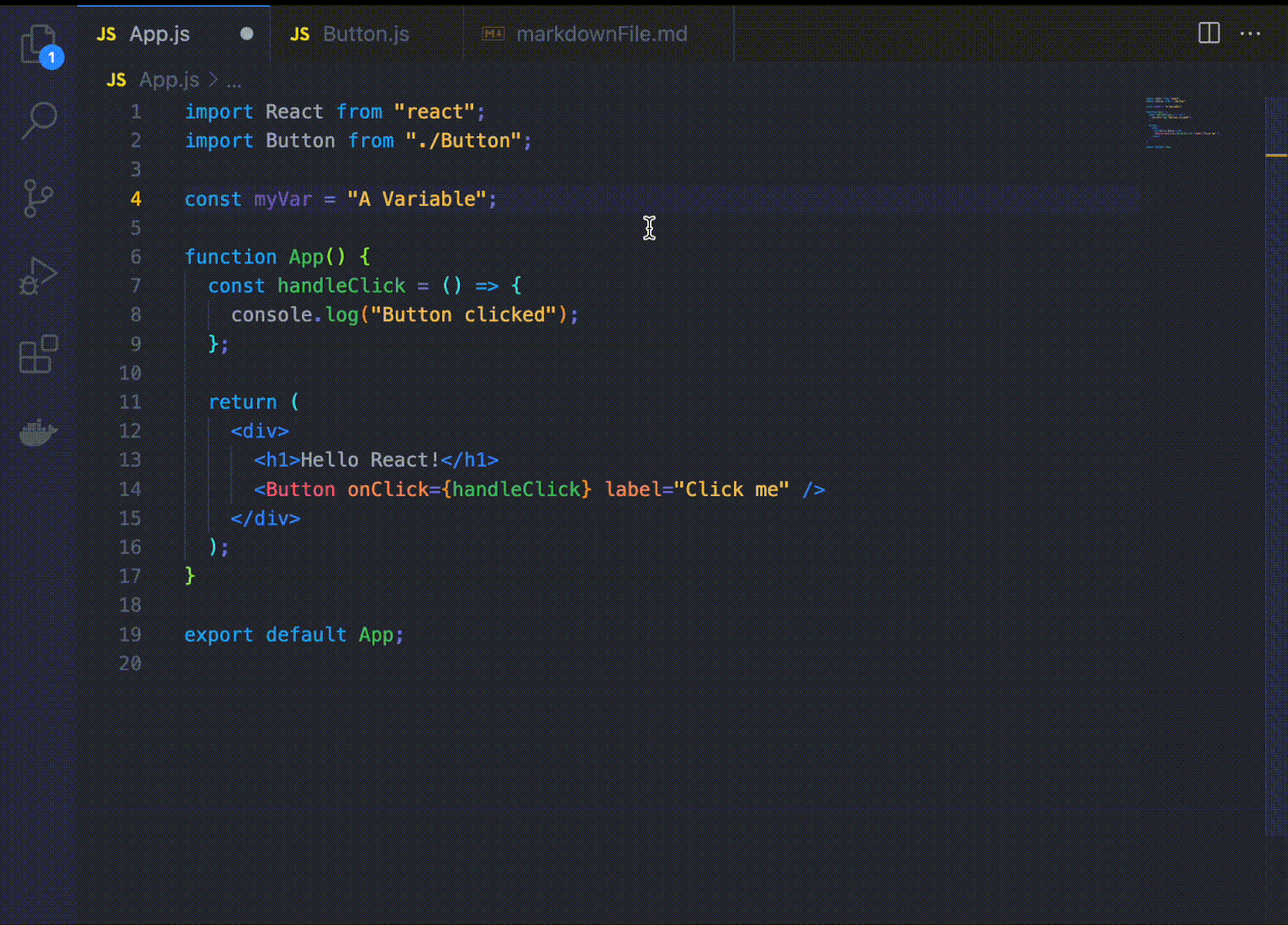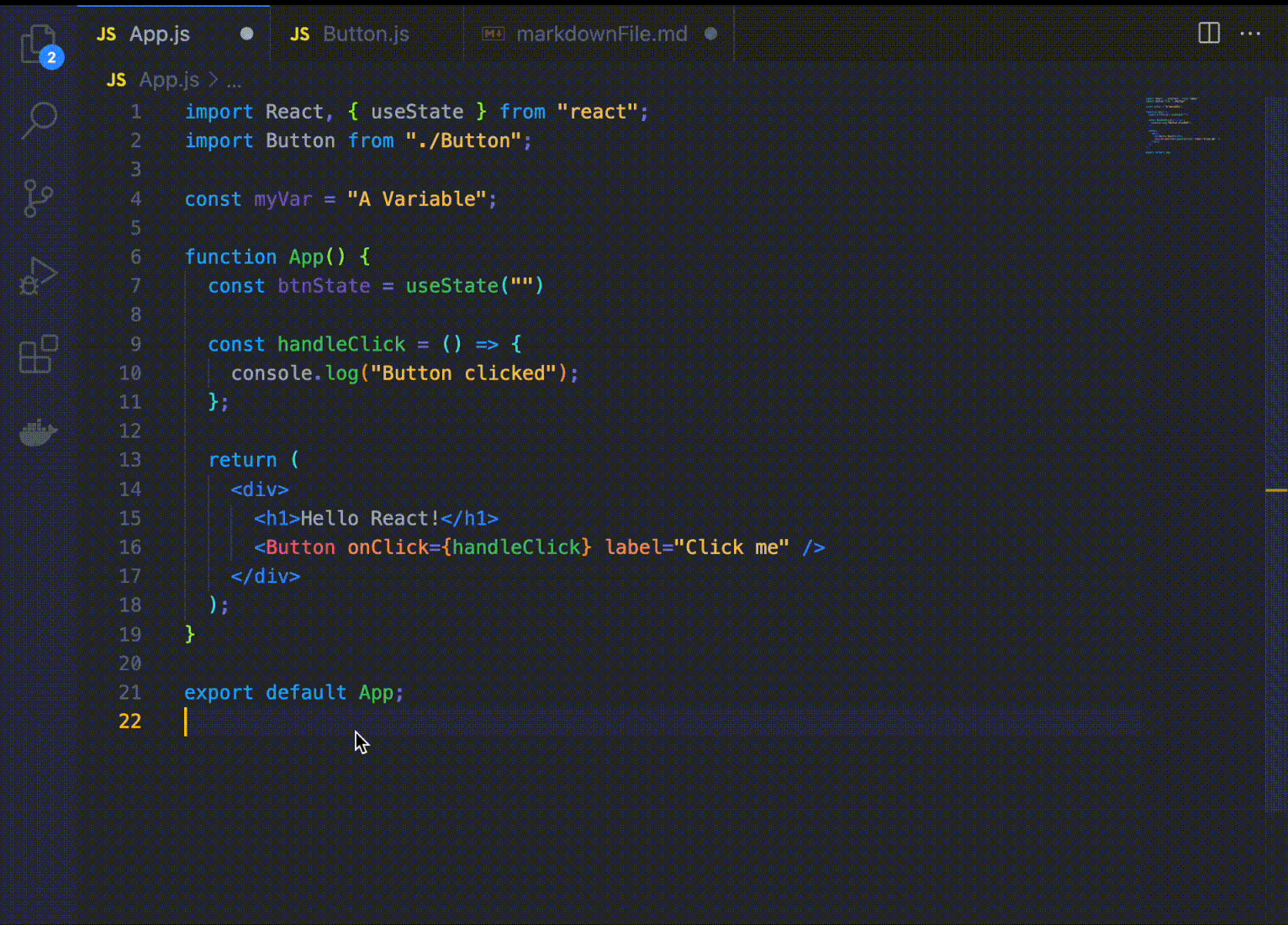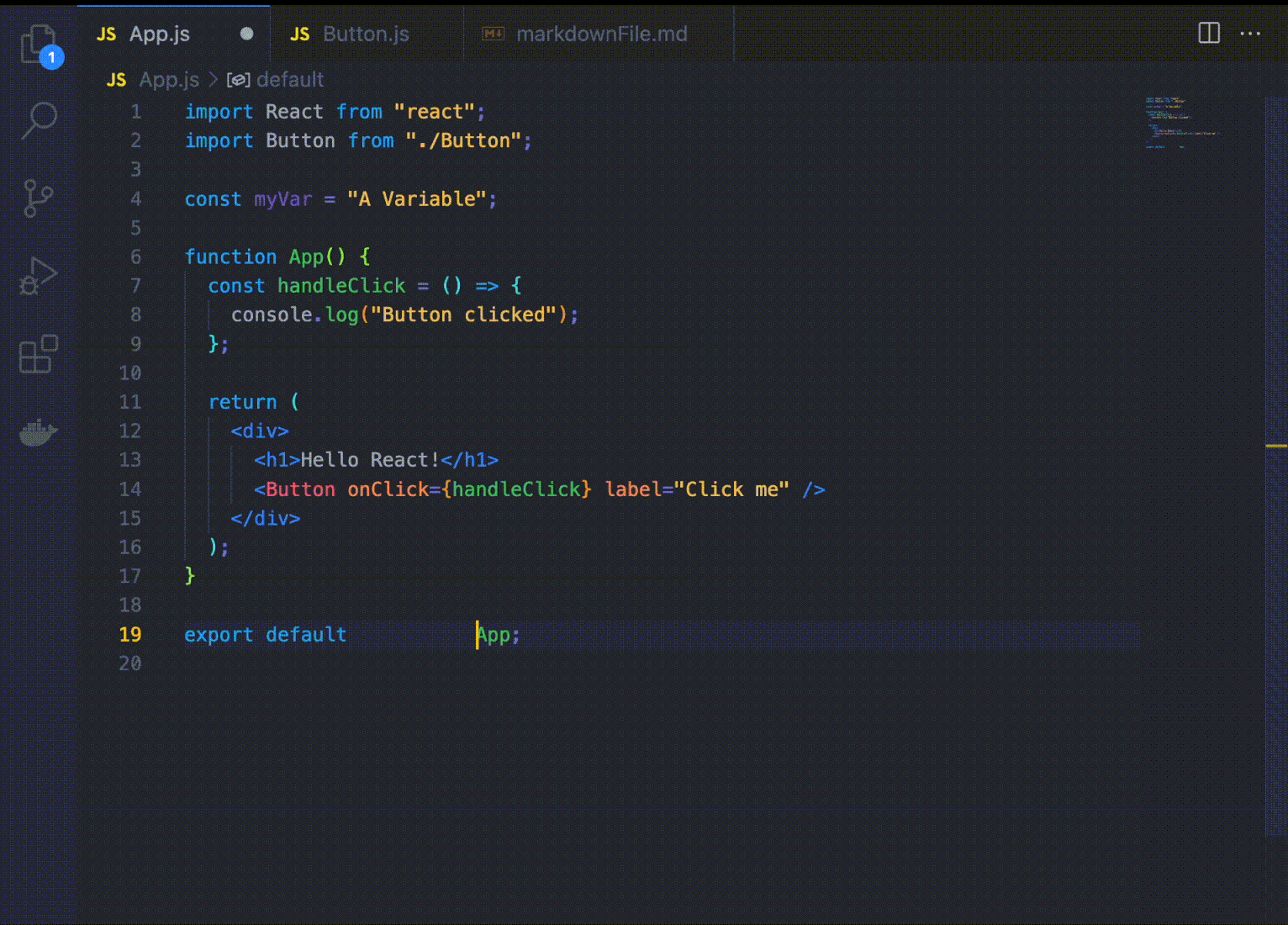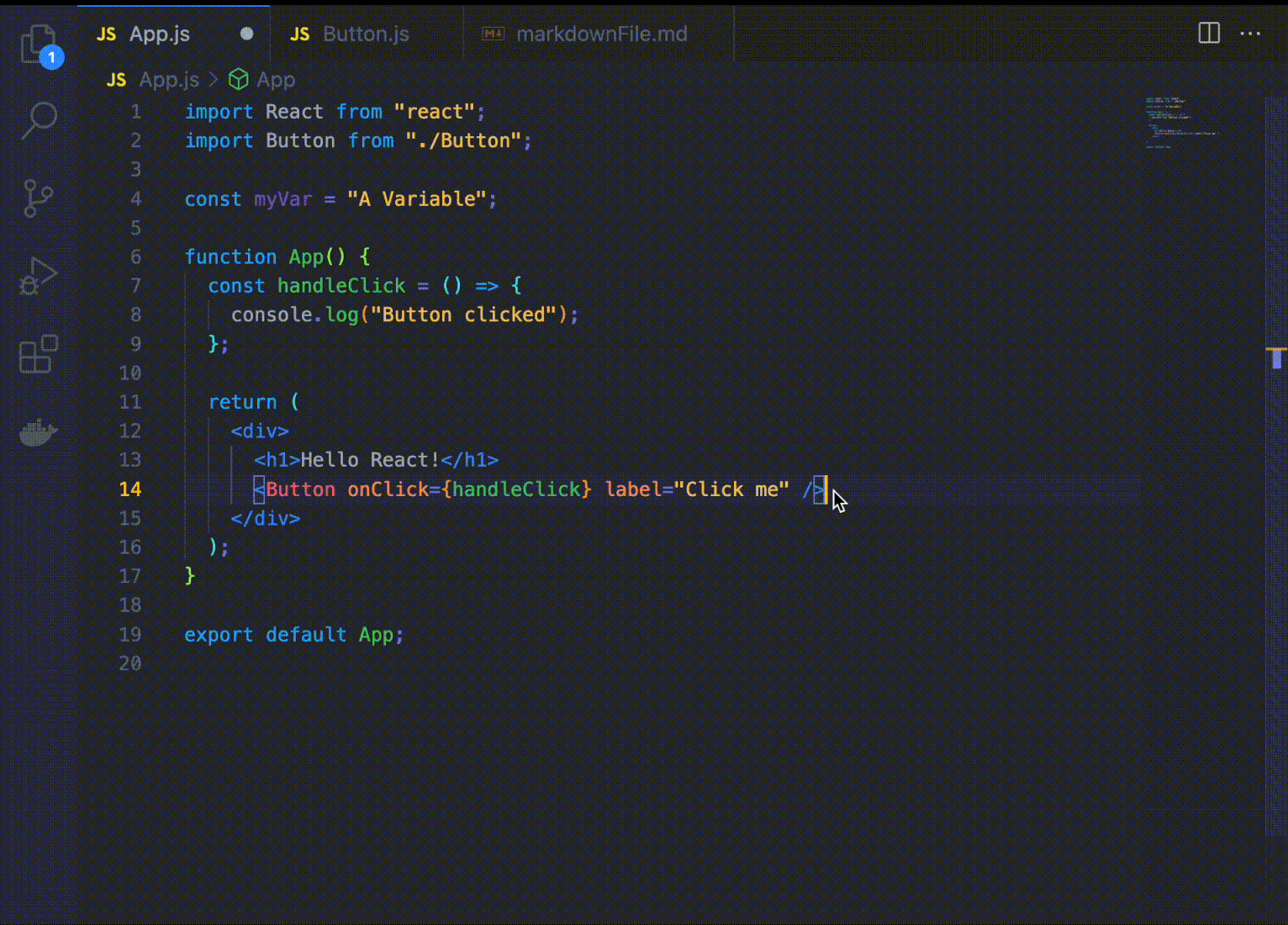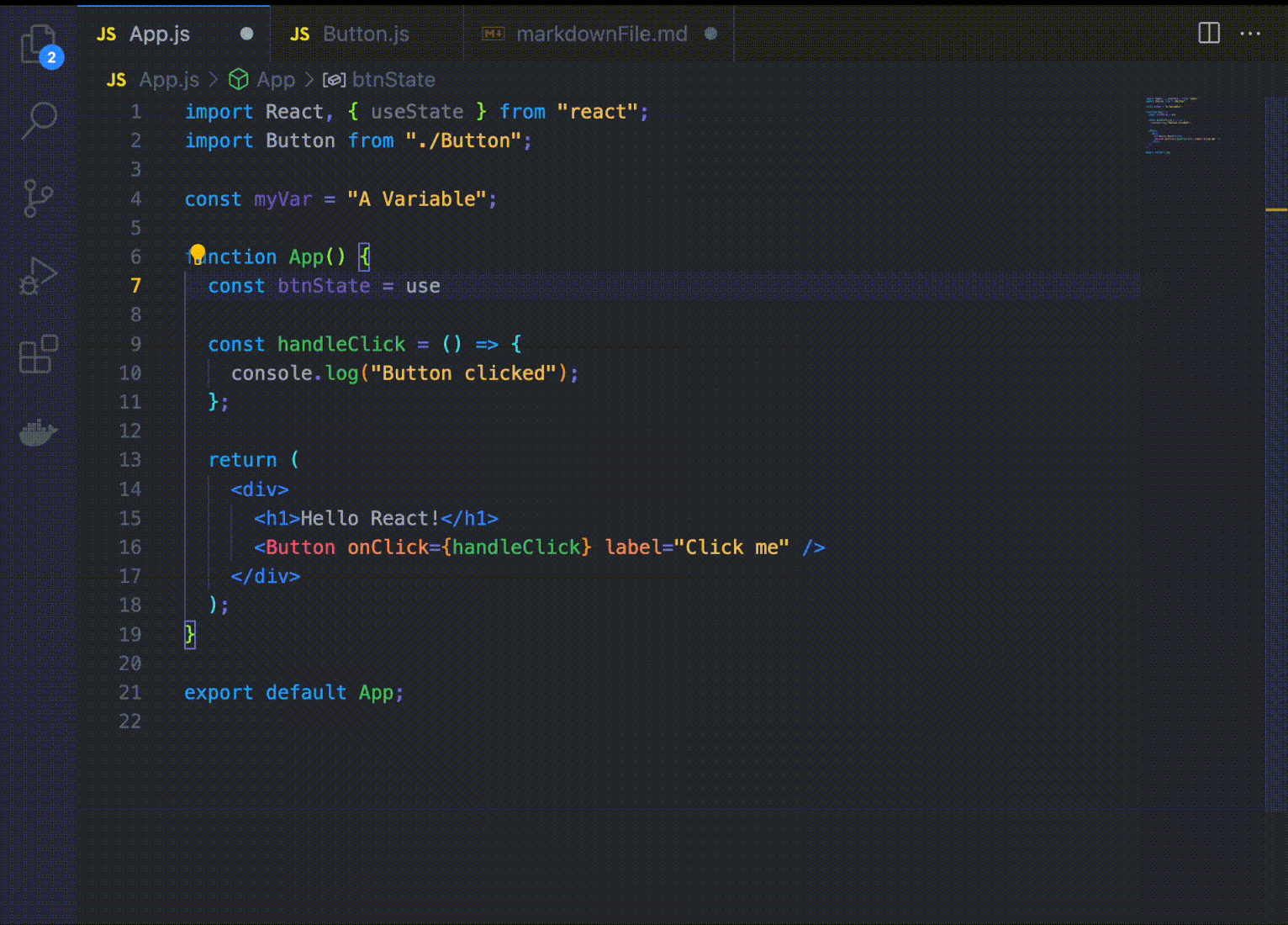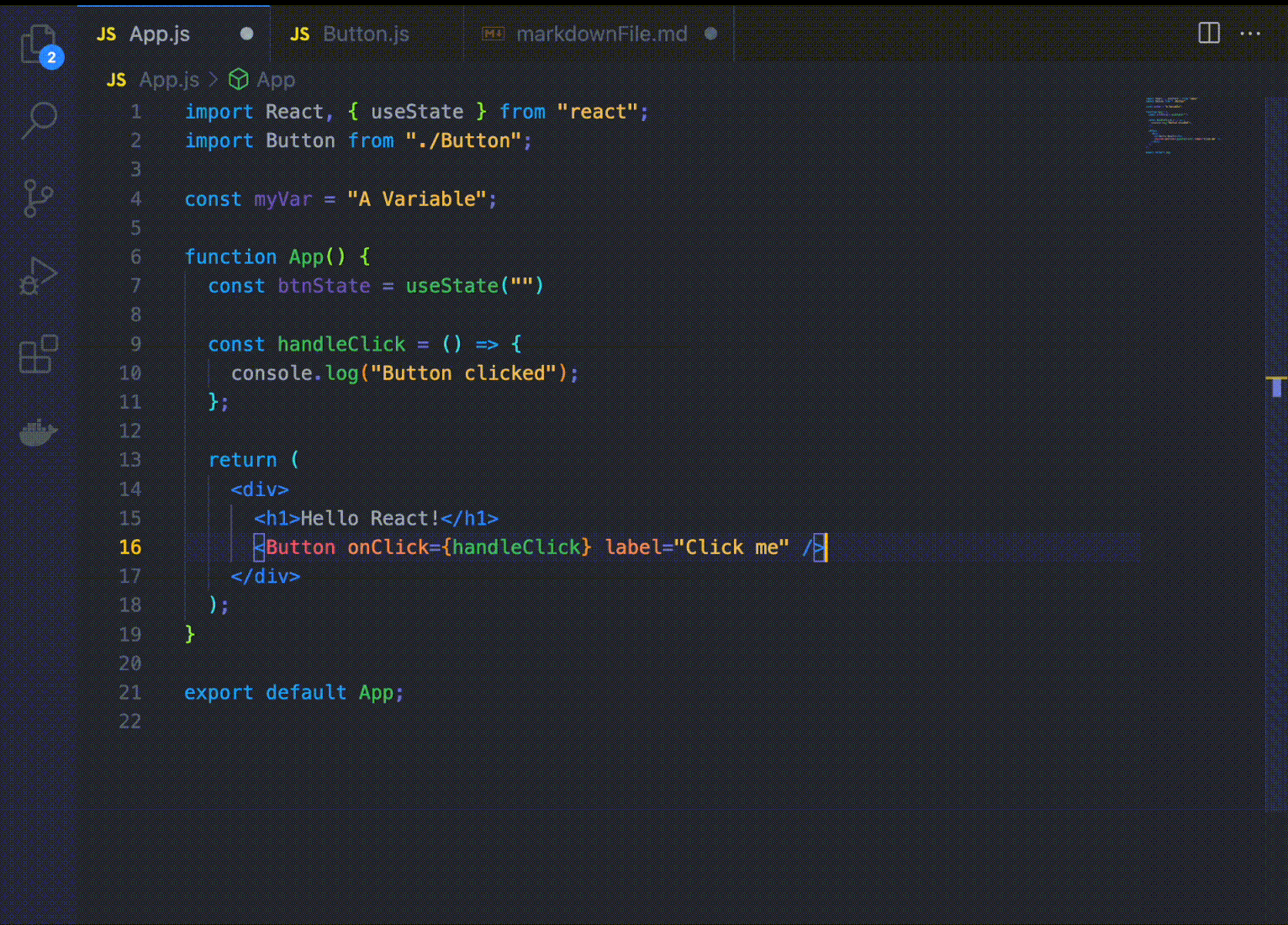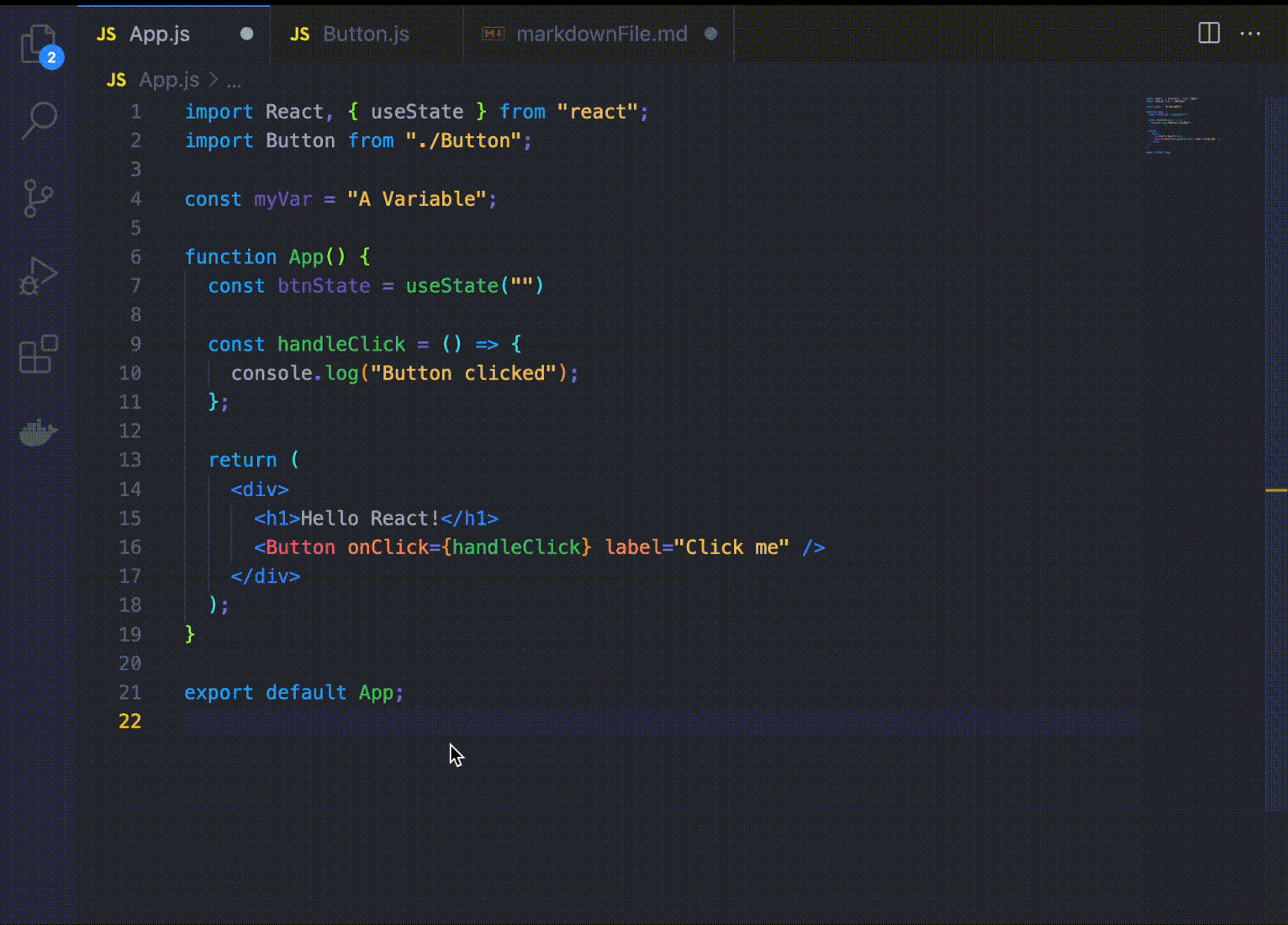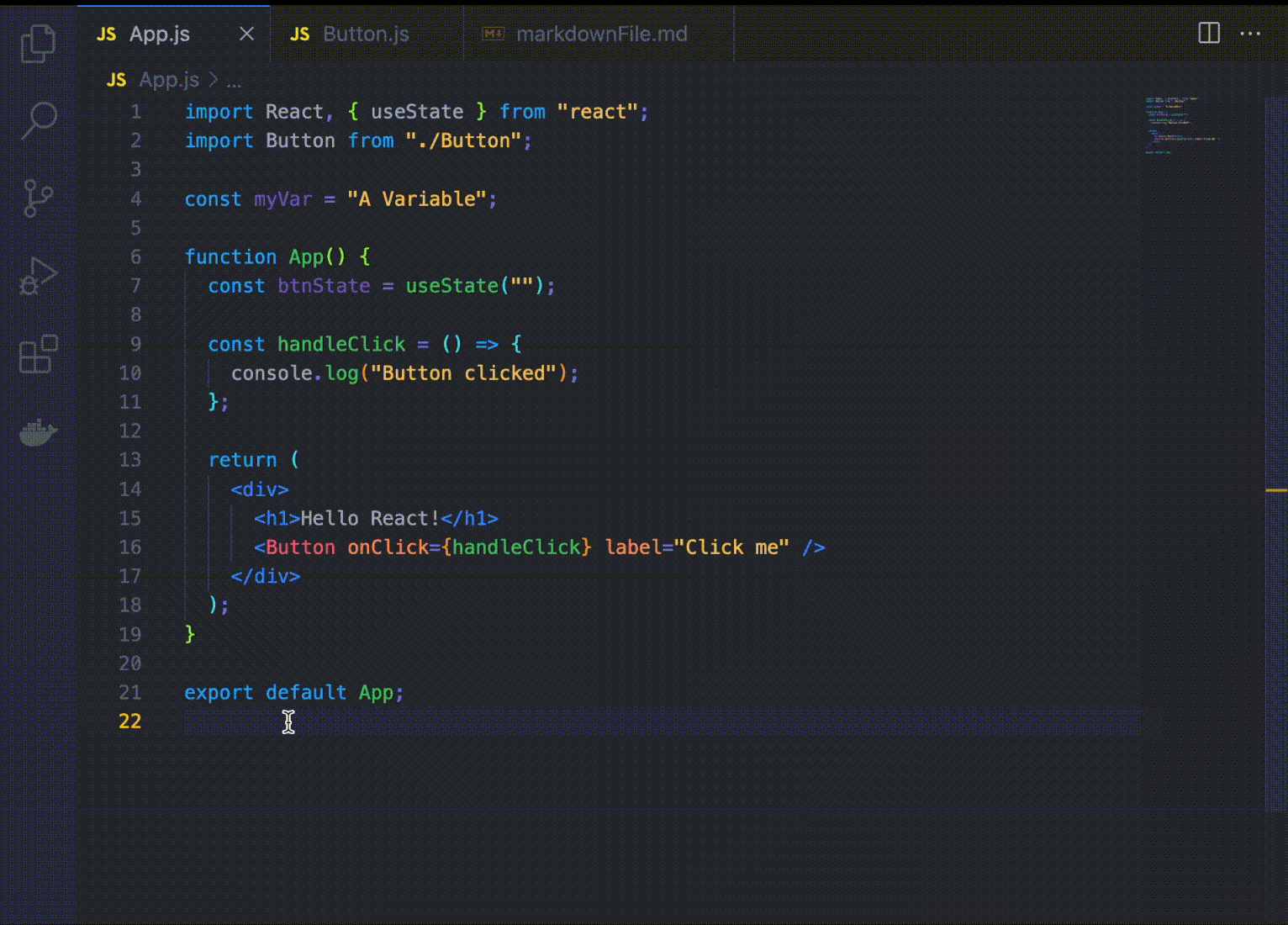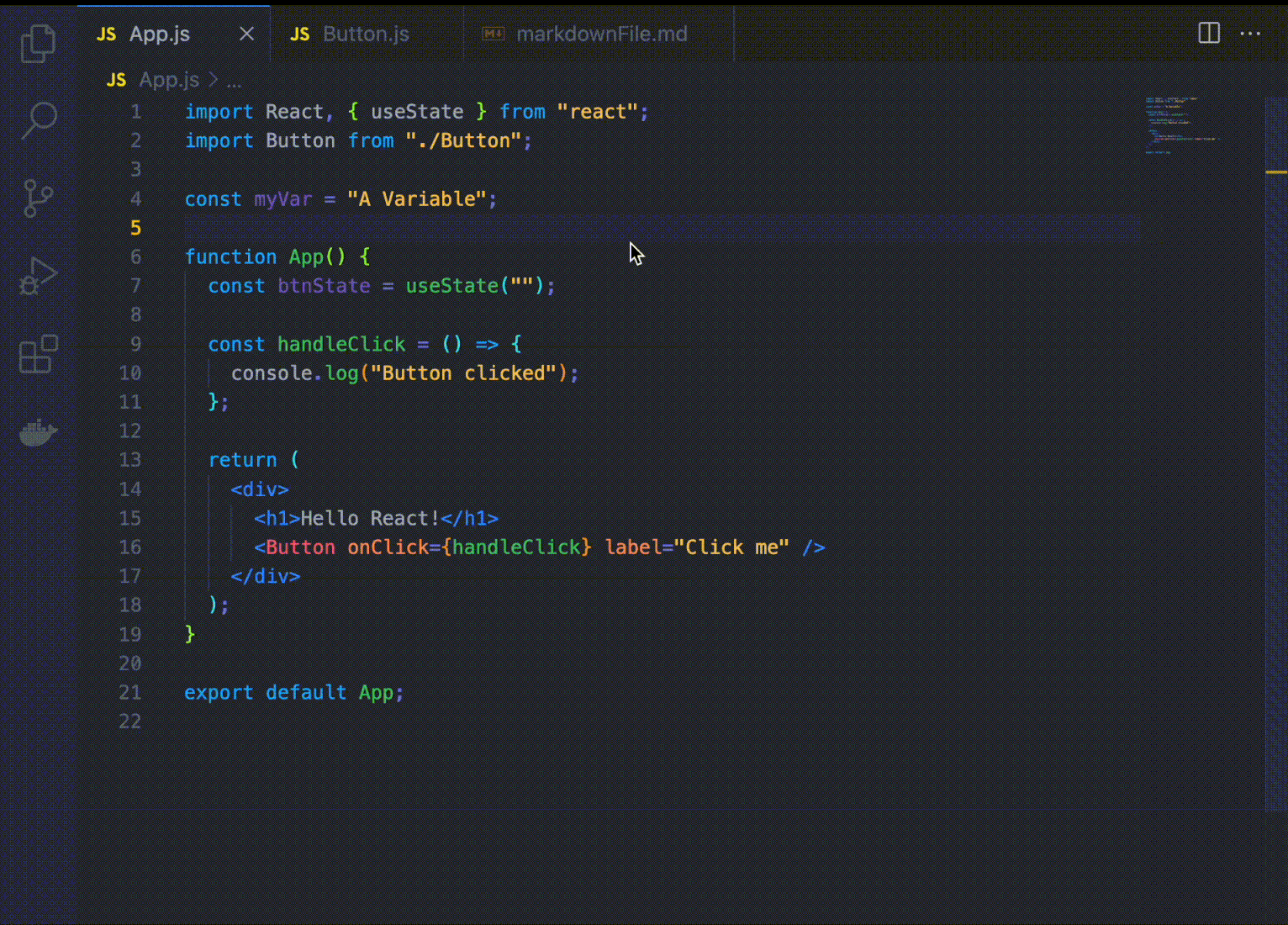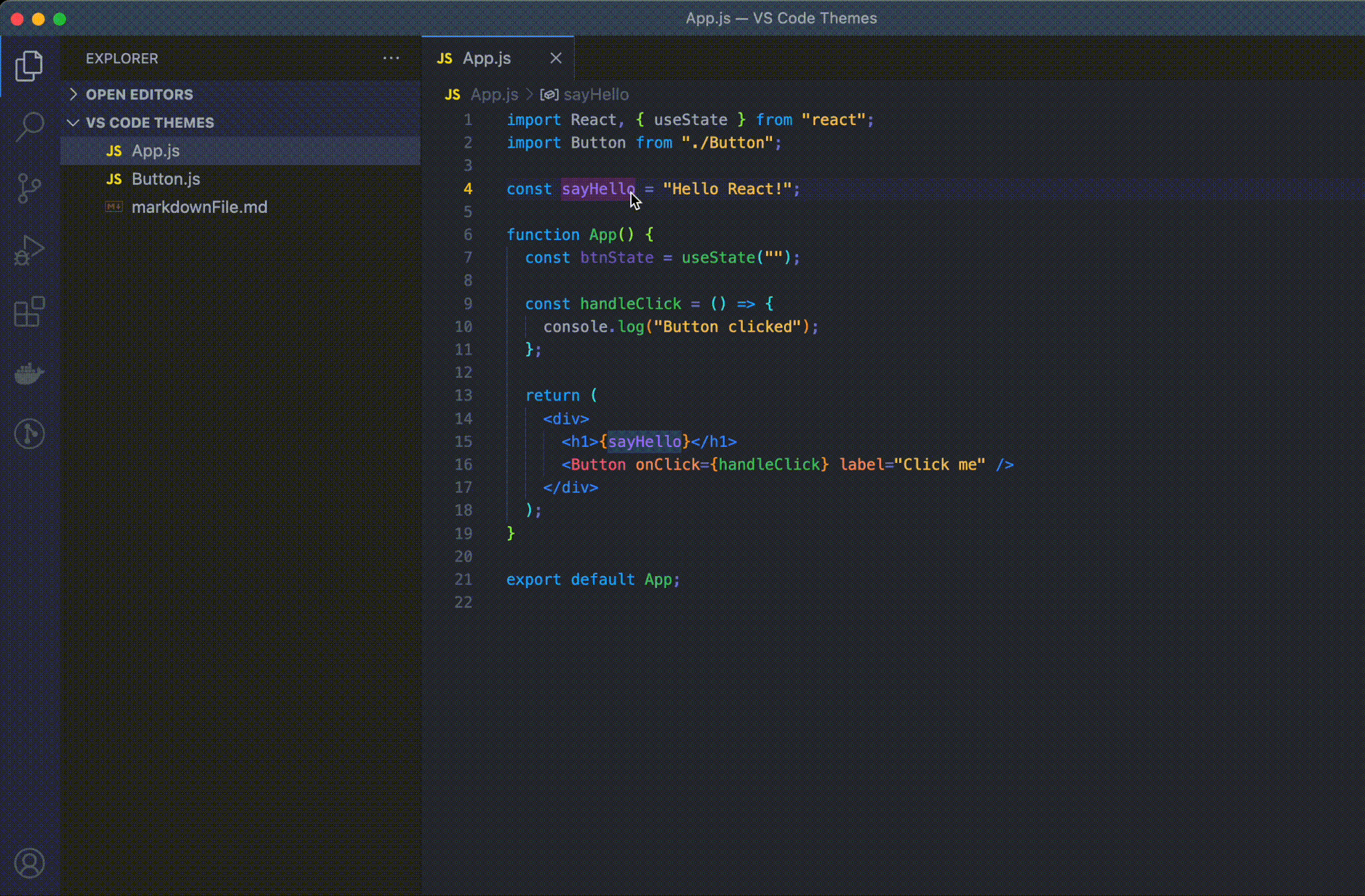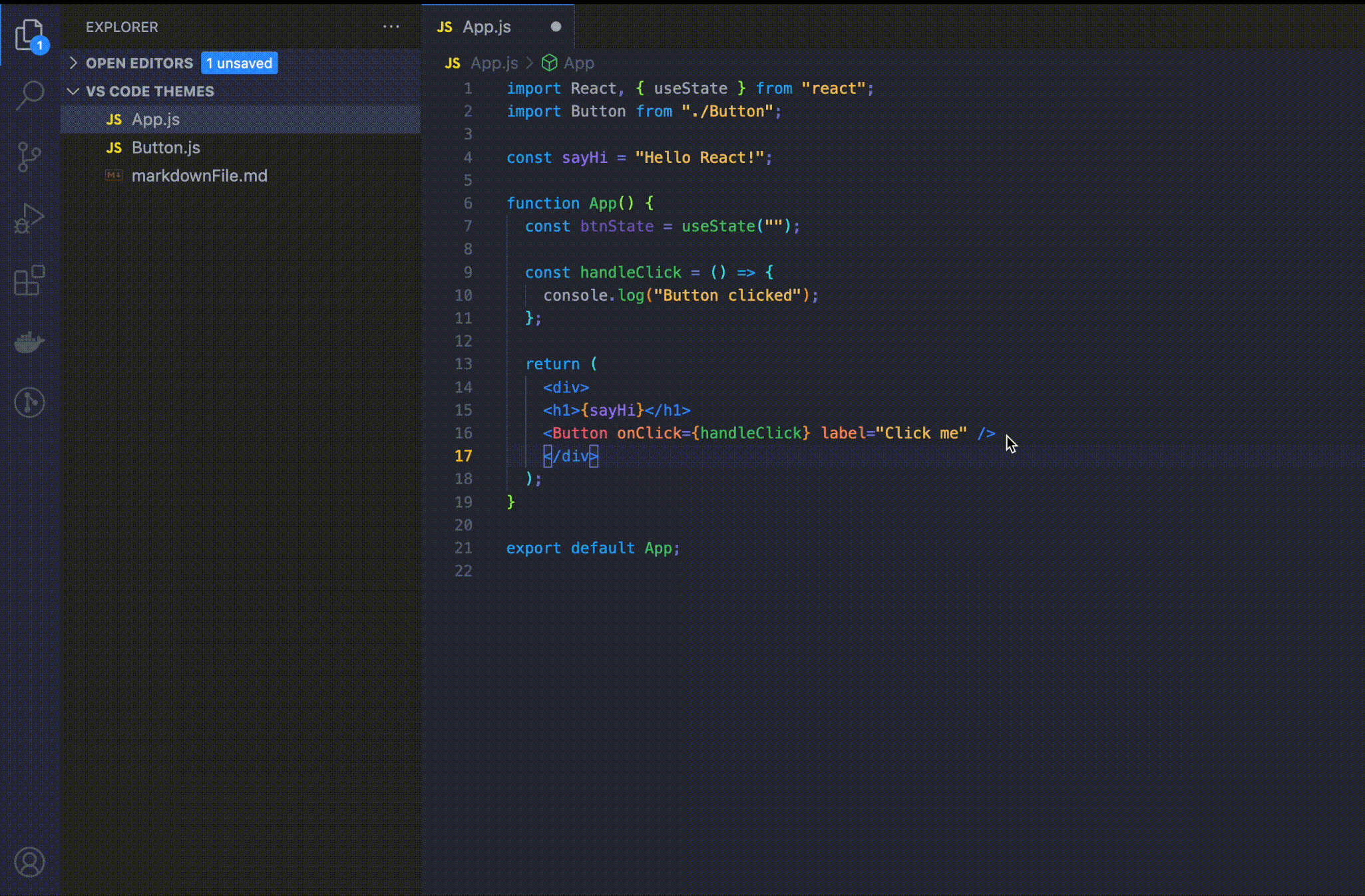In this article, I explore the 30 best vscode shortcuts in 2024.
Whether you're a beginner or an experienced developer, mastering VSC hotkeys in this VSCode cheat sheet will help you to work more efficiently by focusing on writing code rather than performing repetitive actions.
I've also added VS Code shortcuts for Windows and Mac, so whichever tribe you’re in, you’re covered!
Plus, my guide includes detailed gifs that show exactly how each works. Let’s dive in.
30 Best VSCode Shortcuts to Boost Productivity in 2024
1. Zen Mode
Main feature: Enter distraction-free mode
Mac command: Cmd + K, Z
Windows command: Ctrl + K, Z
This allows you to enter full-screen mode, which is ideal for focusing solely on the code you're working on. The interface is minimalistic, and all extraneous elements are hidden, providing a distraction-free environment. To exit, double-click escape.
2. Command Palette
Main feature: Show all commands
Mac command: Cmd + Shift + P
Windows command: Ctrl + Shift + P
This will bring up a search bar where you can search for any command or feature you need, eliminating the need to navigate through various menus and settings, as it offers access to all VS Code commands and features from a single location.
3. Global Find
Main feature: Search within all files
Mac command: Cmd + Shift + F
Windows command: Ctrl + Shift + F
Use this to search for specific text or code within your current file, which is ideal when you're trying to find a particular function or variable in multiple places. It highlights all instances of your search text, allowing you to easily navigate to each.
4. Move a Line Up/Down
Main feature: Move a line up or down
Mac command: Option + Up/Down arrow
Windows command: Alt + Up/Down arrow
This VSC shortcut makes it easy to move a block of code to a different location in the file without having to cut and paste. This is especially useful when you're editing large files with many lines of code.
5. Multi-Select Cursor
Main feature: Add cursor at multiple places
Mac command: Option + Click
Windows command: Alt + Click
You can use this shortcut to place multiple cursors in different locations in a file. This feature can save you time by enabling you to simultaneously make identical changes in different places.
6. Delete a Line
Main feature: Delete a line quickly
Mac command: Cmd + Shift + K
Windows command: Ctrl + Shift + K
This simple but essential feature lets you remove a line of code quickly without selecting it manually or cutting it with the mouse. It can come in handy when you're refactoring code.
7. Comment Code
Main feature: Comment single or multi lines of code
Mac command: Cmd + /
Windows command: Ctrl + /
Using this shortcut, you can add comments to your current selection quickly and with ease. Whether you’re improving documentation, debugging, or want to temporarily disable a block of code, you can use it to comment out a single line or multiple lines of code.
8. Toggle Sidebar
Main feature: Make the sidebar appear or disappear
Mac command: Cmd + B
Windows command: Ctrl + B
When you want to hide or show the sidebar in the editor, this is a shortcut you can use. It’s useful when you need more screen real estate or want to reduce the clutter in the editor. This works in conjunction with the next VSC shortcut, which compares two files at the same time.
9. Split View
Main feature: View files side by side
Mac command: Cmd + \
Windows command: Ctrl + \
This shortcut allows you to split the editor pane into two parts, allowing you to view two different files side by side. Use this when you're comparing two files or referencing one file while working on another.
10. Duplicate Line VSCode
Main feature: Duplicate a line in VSCode
Mac command: Option + Shift + Up/Down arrow
Windows command: Alt + Shift + Up/Down arrow
Here's a common request. Use this copy line VSCode shortcut to quickly replicate your work. It takes a fraction of a second to repeat code blocks or to paste blocks of code without manually selecting them. And there's a reason this made our top ten shortcuts in the list. My experience shows duplicate line VSCode shortcuts are some of the most commonly used for repetitive work.
11. Navigate to a Specific Line
Main feature: Takes you to a specified line
Mac command: Ctrl + G
Windows command: Ctrl + G
With this VSCode go-to line shortcut, you can jump to a specific line in the current file. The command opens a dialog box where you can enter the line number you want to navigate to.
12. Open Settings
Main feature: Open settings panel
Mac command: Cmd + ,
Windows command: Ctrl + ,
Do you want to open the settings panel in VS Code? The quickest way to do so is to use this shortcut, simply click CTRL (for Windows) or CMD for Mac) with the comma (,) key.
13. Trim Trailing Whitespace
Main feature: Remove unwanted whitespace
Mac command: Cmd + K Cmd + X
Windows command: Ctrl + K Ctrl + X
If you want to remove trailing whitespace from the end of lines in your code, consider this VSCode shortcut. I listed out both the Mac command and Windows command, so you can improve your code's readability and avoid unnecessary changes in version control systems.
14. Select the Current Line
Main feature: Select everything on the current line
Mac command: Cmd + L
Windows command: Ctrl + L
Use this shortcut when you want to select a piece of text or code on a line. This feature will select the entire line the cursor is currently on. With this, you don’t need to manually highlight the line with the mouse.
15. Open Markdown preview
Main feature: Preview a markdown document
Mac command: Shift + Cmd + V
Windows command: Shift + Ctrl + V
This VS Code shortcut lets you preview your Markdown files in a separate pane. This feature can be useful when you're writing documentation or other text-based content using Markdown, such as ReadMe files.
16. Fold/Unfold Code Block
Main feature: Collapse or expand code block
Mac commands: Option + Cmd + [ to fold | Option + Cmd + ] to unfold
Windows commands: Ctrl + Shift + [ to fold | Ctrl + Shift + ] to unfold
When working with long files or files containing large blocks of code, you will sometimes want to collapse and expand code blocks. That’s when this shortcut comes in handy.
17. Show References
Main feature: Quickly find reference to a symbol
Mac command: Cmd + Shift + click
Windows command: Shift + F12
To use this VSCode shortcut, first, place your cursor on the symbol you want to find references for, then press the shortcut key combination. This will open a panel with a list of all the references to that symbol in your project.
18. Trigger Suggestion/Parameter Hints
Main feature: Show auto-complete suggestions
Mac command: Cmd + Shift + Space
Windows command: Ctrl + Shift + Space
This triggers code completion suggestions and parameter hints for the current code context. This feature can help speed up your workflow.
19. Show All Symbols
Main feature: Show all symbols in the current file
Mac command: Cmd + T
Windows command: Ctrl + T
This VSC shortcut lets you see a list of the current file's symbols (functions, classes, etc.). This feature can help you navigate large files quickly.
20. Go Back/Move Forward
Main feature: Navigate forward/backward
Mac command: Ctrl - or Ctrl + UpArrow -
Windows command: Alt + Left/Right Arrow
Navigate through your code history and jump between previous cursor positions in the file with this go-back/move-forward shortcut. It’s a useful shortcut when you need to quickly retrace your steps or switch between different parts of your code.
21. Show Integrated terminal
Main feature: Toggle integrated terminal
Mac command: Ctrl + `
Windows command: Ctrl + `
The shortcut allows you to use the integrated Terminal in VS Code. It allows developers to run commands on the terminal without leaving VS Code.
22. Zoom In/Out
Main feature: Zoom in and out of the current file
Mac command: Cmd + =/Minus
Windows command: Ctrl + =/Minus
Zooming is a useful VS Code shortcut when you need to view your code more closely or when you need to adjust the font size to improve readability.
23. Show Extensions
Main feature: Toggle extensions panel
Mac command: Shift + Cmd + X
Windows command: Shift + Ctrl + X
If you want to see the extensions you have in your VS Code, you can use this shortcut, as it will toggle the extensions panel. By default, this panel appears on the left to display all the extensions you’ve installed in VS Code.
24. Show Search Bar
Main feature: Toggle the search bar
Mac command: Cmd + F
Windows command: Ctrl + F
Use this shortcut to open the search bar in VS Code. This feature is useful when searching for specific content within a file or across multiple files in your project.
25. Quick Open
Main feature: Open a specific file
Mac command: Cmd + P
Windows command: Ctrl + P
You can use this VSC shortcut to navigate to a specific file in your project. It opens a dialog box to search for files by name or browse the file hierarchy. It can come in handy when working on large projects with many files.
26. Create New File
Main feature: Quickly create new files
Mac command: Cmd + N
Windows command: Ctrl + N
This opens a new window in the editor with an untitled file, which you can then save and name appropriately. It’s useful because it eliminates the need to navigate through the file explorer anytime you want to create a new file.
27. Toggle Full Screen
Main feature: Enable and disable full-screen mode
Mac command: Ctrl + Cmd + F
Windows command: F11
When you want to maximize your workspace and remove distractions, using the full-screen mode is a feature that comes in handy. It’s also useful for times when you are working on a device with a smaller screen.
28. Renaming Symbols
Main feature: Rename all instances of a symbol
Mac command: F2
Windows command: F2
This VSC shortcut lets you rename all occurrences of a symbol (variable, function, class, etc.) in your project. This feature is useful, especially when you need to refactor code and consistently change all instances of a symbol.
29. Indent/Outdent Lines
Main feature: Properly indent lines of code
Mac commands: Cmd + ] to indent | Cmd + [ to outdent
Windows commands: Ctrl + ] to indent | Ctrl + [ to outdent
Every now and then, you will need to indent or outdent a piece of text or code. First, select the lines that you want to indent/outdent. Then click CMD (Mac) or CTRL(Window) and the closing square bracket `]` button.
30. Show Output Panel
Main feature: Display the output panel
Mac command: Shift + Cmd + U
Windows command: Shift + Ctrl + U
This shortcut allows you to open the Output panel in your VS Code. That way, you can view the output of running programs or other system messages the editor generates.
Why Are VSCode Shortcuts Important?
Let’s take a look at the benefits of using VS Code with shortcuts.
- Improve work speed: Visual Studio Code keyboard shortcuts allow you to perform tasks faster than with the mouse or menu.
- Customizability: VS Code allows you to customize keyboard shortcuts to fit your workflow, which is ideal for commands that you use frequently.
- Ability to multitask: Visual Studio short keys let you perform multiple tasks simultaneously, like navigating to a specific line and searching for a particular keyword.
- Ease of use: Over time, VSCode keyboard shortcuts become easier to use than navigating menus and submenus while also reducing the strain on your wrist and fingers from constant mouse clicks.
What Are the Different Types of VSCode Shortcuts?
Let’s take a look at some of the most useful types of Visual Studio Code shortcuts you can use.
- Basic Editing VSC Shortcuts: Perform common text editing tasks in VS Code, such as selecting text, copying and pasting, insert cursor, move to the end of each line, and undoing and redoing changes.
- File Management Shortcuts: Used to work with files and folders in VS Code, such as opening and closing files, saving changes, and creating new files.
- Display Shortcuts: Used to manipulate how code and other content is displayed in the editor, such as zooming in and out, toggling between different editor layouts, etc.
- Integrated Terminal Shortcuts: For working with the integrated terminal in VS Code.
- Navigation Shortcuts: For moving around within the editor and also between files and symbols.
So whether you’re working on the front end in your JavaScript code editor or you’re building out the backend in Python, VSCode shortcuts can boost your productivity.
Looking for a deeper dive with more advanced functionality, beyond keyboard time-savers? I found this worthwhile book on Visual Studio Code for Python Programmers.
Best Practices for Finding & Using Shortcuts in VSCode
- Use the Command Palette: A powerful tool in VS Code that allows you to search for and execute commands using shortcuts. To access this, press Ctrl+Shift+P (Windows, Linux) or Cmd+Shift+P (Mac) and start typing the command you want to execute. You can also list all shortcuts by typing 'Keyboard Shortcuts Reference' to learn how to quickly close window, find next error, insert line, and more.
- Customize shortcuts to fit your workflow: If you use certain commands frequently, consider customizing keyboard shortcuts to fit your workflow. Go to "File > Preferences > Keyboard Shortcuts" (Windows) or "Code > Preferences > Keyboard Shortcuts" (Mac) and search for the command you want to customize. Click the pencil icon next to the command and enter a keyboard shortcut using any keys that make sense, including tab, esc, arrow key, etc.
- Practice: Learning shortcuts takes practice and repetition. Make an effort to use shortcuts often and over time to develop muscle memory.
- Share VSC shortcuts with your team: If you work in a team, sharing shortcuts with colleagues can improve collaboration and make coding easier.
Wrapping Up
Using shortcuts in Visual Studio Code is a great way to improve productivity and speed up your workflow as a developer. Whether you're working on a large project or just making small edits to your code, the right shortcuts can save you time and effort.
While I've discussed how to personalize themes in the past, in this article, I've covered 30 of the most useful and commonly used VSCode shortcuts in 2024.
These include basic editing shortcuts, file management shortcuts, display shortcuts, integrated terminal shortcuts, and navigation shortcuts.
By using these VSC shortcuts regularly, you can build your muscle memory, and in no time at all, you’ll be using them with little effort.
So get started today and take advantage of these shortcuts by incorporating them into your workflow.
Are you ready to use VSCode to level up your portfolio by building projects? Check out:
Dr. Anglea Yu's 100 Days of Code: The Complete Python Pro Bootcamp










